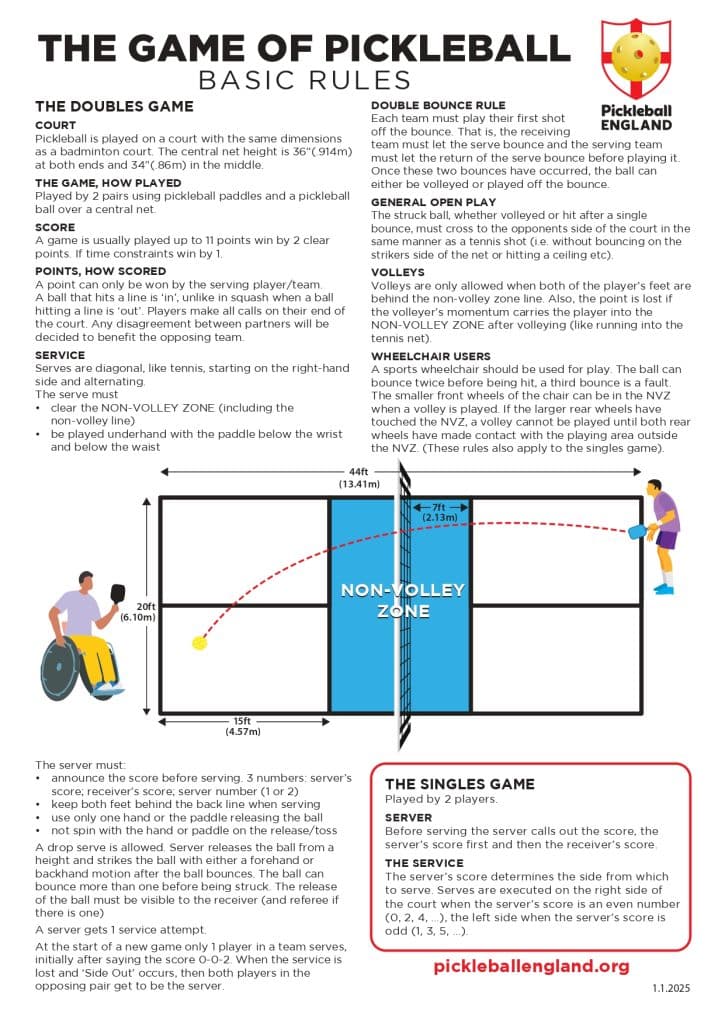The Basics of Pickleball Rules
Pickleball is one of the fastest-growing sports in the UK, offering a fun mix of tennis, badminton and table tennis. Whether you’re brand new to the game or brushing up before a competition, understanding the pickleball rules is essential. This guide covers everything you need to know — from serving and scoring to faults and the kitchen zone — all aligned with the official Pickleball England and international rulebook.
CLICK HERE for a copy of the 2025 Official Rule Book.
Court Layout and Equipment:
Pickleball is played on a badminton-sized court (6.1m x 13.4m) with a 36-inch net at the sidelines and 34 inches at the centre. Players use solid paddles and a perforated plastic ball, designed for indoor or outdoor play.
Serving Rules
- The server must stand behind the baseline.
- The ball is hit underhand, from the right side of the court (below waist height), with the paddle face moving upward.
- The serve must land diagonally in the opponent’s service box, clearing the non-volley zone (kitchen).
- Only one serve attempt is allowed.
The Double Bounce Rule
After a serve, the receiving team must let the ball bounce once before returning it. The serving team must then also allow one bounce before playing the ball. After these two bounces, volleys (hitting the ball out of the air) are permitted. This rule encourages longer rallies and balanced play.
Scoring in Pickleball:
Points can only be scored by the serving side. You win a point if the defending side does not manage to return the ball, hits the ball out, does not let the serve ball bounce, volleys in the non-volley zone, or is hit by the ball. The game ends when one of the parties gets 11 points, with a 2-point lead.
When a side scores a point, the same person serves, but from the other side of the court. When a player loses a point, his or her partner serves from the side of the court where he or she is standing at the moment. If this service also fails to score, service goes to the opponent and the opponent begins the service on the right. For the first service, however, the service changes sides after only one serve.
When playing singles, the player serves from the left if he or she has an uneven number of points, and from the right with an even number of points. This is how scoring is kept: 1-0-1 means that the serving side has 1 point, the other side has no points, and this is the first server.
Faults and Common Mistakes:
Understanding faults helps avoid confusion and keeps play fair.
Service Faults
- Serving into the net or out of bounds.
- Serving into the Non-Volley Zone.
Non-Volley Zone Rules
- Players cannot volley (hit the ball out of the air) while standing in the non-volley zone.
- Momentum cannot carry a player into the non-volley zone after a volley, even if the ball is already dead.
- Groundstrokes (after a bounce) are allowed in the non-volley zone.
Line Calls
- A ball touching any part of the sideline or baseline is considered in.
- Players make their own line calls, with an emphasis on good sportsmanship.
Next Steps:
Mastering the rules ensures fair play, makes the game more enjoyable, and prepares you for club or tournament play. Whether you’re a beginner learning the basics or an experienced player competing in sanctioned events, understanding the rules of pickleball will elevate your game.
Why not pay a visit to your local club or take a look at our qualified coaches list? We assure you, if you’ve not tried Pickleball before, you’re about to become hooked!
Click here to download our rules summary.

